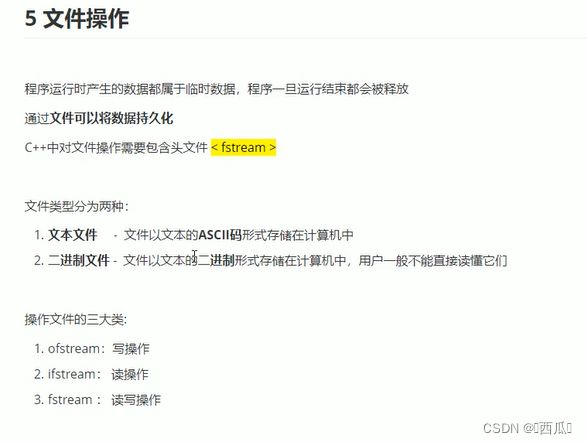C++文件操作->文本文件(->写文件、读文件)、二进制文件(->写文件、读文件)
#include
using namespace std;
#include
//文本文件 写文件
void test01()
{
//1.包含头文件 fstream
//2.创建流对象
ofstream ofs;
//3.指定打开方式
ofs.open("test.txt", ios::out);
//4.写内容
ofs << "姓名:张三" << endl;
ofs << "性别:男" << endl;
ofs << "年龄:18" << endl;
//5.关闭文件
ofs.close();
}
int main() {
test01();
system("pause");
return 0;
}
总结:
* 文件操作必须包含头文件 fstream
* 写文件可以利用 ofstream ,或者fstream类
* 打开文件时候需要指定操作文件的路径,以及打开方式
* 利用<<可以向文件中写数据
* 操作完毕,要关闭文件
#include
using namespace std;
#include
#include
//文本文件 读文件
void test01()
{
//1.包含头文件
//2.创建流对象
ifstream ifs;
//3.打开文件 并且判断是否打开成功
ifs.open("test.txt", ios::in);
if (!ifs.is_open())
{
cout << "文件打开失败" << endl;
return;
}
//4.读数据
//第一种方式
//char buf[1024] = { 0 };
//while (ifs >> buf)
//{
// cout << buf << endl;
//}
//第二种
//char buf[1024] = { 0 };
//while (ifs.getline(buf,sizeof(buf)))
//{
// cout << buf << endl;
//}
//第三种
//string buf;
//while (getline(ifs, buf))
//{
// cout << buf << endl;
//}
//第四种
char c;
while ((c = ifs.get()) != EOF)//EOF end of file文件尾部的标准
{
cout << c;
}
//5.关闭文件
ifs.close();
}
int main() {
test01();
system("pause");
return 0;
}
总结:
- 读文件可以利用 ifstream ,或者fstream类
- 利用is_open函数可以判断文件是否打开成功
- close 关闭文件
#include
using namespace std;
#include
#include
//二进制文件 写文件
class Person
{
public:
char m_Name[64];//姓名
int m_Age;//年龄
};
void test01()
{
//1、包含头文件
//2、创建流对象
ofstream ofs("person.txt", ios::out | ios::binary);
//3、打开文件
//ofs.open("person.txt", ios::out | ios::binary);
//4、写文件
Person p = {"张三" , 18};
ofs.write((const char *)&p, sizeof(p));
//5、关闭文件
ofs.close();
}
int main()
{
test01();
system("pause");
return 0;
}
总结:
* 文件输出流对象 可以通过write函数,以二进制方式写数据
#include
using namespace std;
#include
#include
//二进制文件 读文件
class Person
{
public:
char m_Name[64];//姓名
int m_Age;//年龄
};
void test01()
{
//1.包含头文件
//2.创建流对象
ifstream ifs("person.txt", ios::in | ios::binary);
//3.打开文件 判断文件是否打开成功
if (!ifs.is_open())
{
cout << "文件打开失败" << endl;
}
//4.读文件
Person p;
ifs.read((char *)&p, sizeof(p));
cout << "姓名: " << p.m_Name << " 年龄: " << p.m_Age << endl;
//5.关闭文件
ifs.close();
}
int main() {
test01();
system("pause");
return 0;
}
总结- 文件输入流对象 可以通过read函数,以二进制方式读数据






